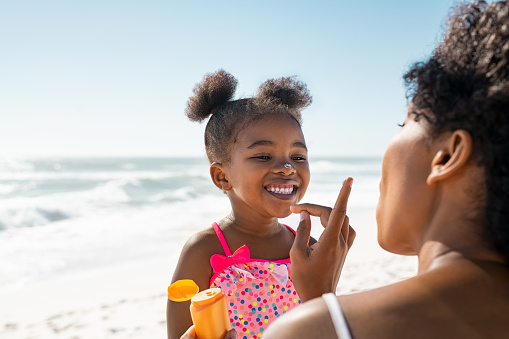Fun in the sun is a given during the summer months, but spending lots of time outside in the sun can lead to sunburn. What’s the best way to protect your child’s skin from sun damage while they enjoy the outdoors?
Dr. Dan Grove, pediatric dermatologist, provides some answers.

When it comes to sun protection, parents have several options.
- Try wide brimmed hats, sunglasses, sunblock, UPF clothing, and minimizing prolonged sun exposure to protect your child’s skin.
- Keep in mind that peak hours for ultraviolet (UV) exposure are between 10 a.m. and 4 p.m. and that cloudy days are not a replacement for sun safe behaviors.
- Using sunscreen is vital to protecting your child’s skin.
“Sunscreens contain zinc oxide and titanium dioxide as their active ingredients, and these perform better than chemical sunscreens,” says Dr. Grove. “I recommend SPF 30+ and encourage SPF 50 during more high-risk activities such as beach vacations, summer camps, and prolonged activities during peak sunlight hours (10 a.m.-4 p.m.). Although skin type can influence the amount of UV rays absorbed, I recommend these tips to all of my patients.”
Don’t leave your sunscreen out in the heat
Regardless of the type of sunscreen you use, if you leave it out in the heat while you’re enjoying the sun, it becomes less effective. The Food and Drug Administration (FDA) recommends not keeping your sunscreen containers in direct sun or in a place that could experience excessive heat, like the inside of a car.
To keep your sunscreen safe from sun and heat, the FDA suggests putting it in the shade, wrapping it in towels or storing it inside a cooler.
Dr. Grove also offers these tips:
- Before your child heads outside and about 15 minutes before sun exposure, apply an ounce of sunscreen (an entire palm of your hand) to any exposed skin. Reapply sunscreen every two hours. If your child is swimming, reapply every 40-80 minutes, depending on the type of sunblock you use.
- If your child gets a sunburn, they should avoid sun exposure on that area. In addition, you can apply cool compresses and moisturizers, and give your child pain relievers if they’re in discomfort. If your child’s sunburn blisters, they are dehydrated or are nauseous, seek medical attention.
If you have questions about your child’s sunburn, call your pediatrician or visit Akron Children’s Pediatrics to find one.










